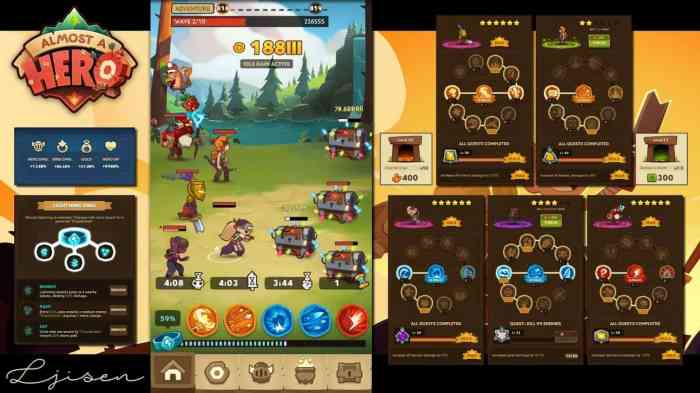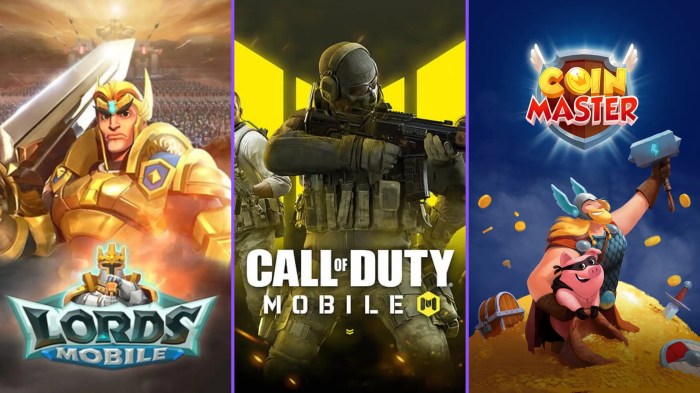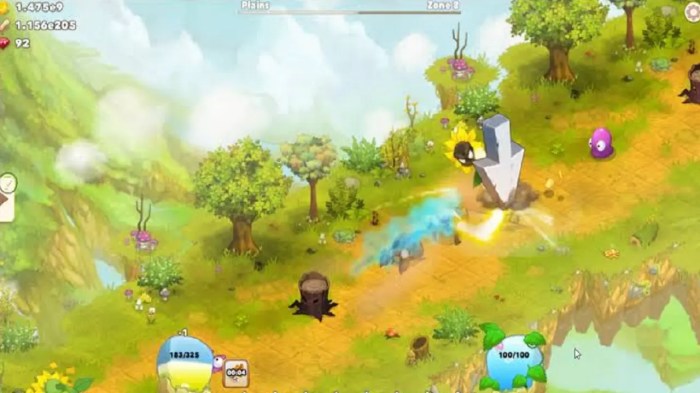Highly addictive offline clicker games for Android with progression are everywhere! These games, with their deceptively simple mechanics, have captivated millions. But what makes them so irresistibly addictive? Is it the satisfying click-click-click, the constant stream of incremental progress, or something more sinister? We’ll dive into the psychology behind these games, explore their monetization strategies, and examine what makes a truly great offline clicker.
Get ready to unlock the secrets of their addictive design!
From the satisfying thud of each click to the exponential growth of your resources, these games masterfully exploit our inherent desire for progress and accomplishment. We’ll be exploring the core mechanics, the psychology of reward systems, and the ethical considerations of their monetization strategies. We’ll also be looking at some of the best examples of these games, analyzing what makes them tick and what makes them so hard to put down.
So, grab your phone, get comfy, and let’s delve into the fascinating world of offline clicker games!
Game Mechanics & Progression Systems

Offline clicker games thrive on their deceptively simple yet deeply engaging gameplay loops. The core mechanic revolves around repeatedly clicking a button (or tapping the screen) to accumulate resources, which are then invested to automate the process and unlock further advancements. This seemingly straightforward system, however, hides a surprising amount of complexity in its progression systems, carefully designed to keep players hooked for extended periods.
The key lies in balancing the initial ease of progress with the ever-increasing challenge required to maintain player engagement in the long term.
Resource Acquisition, Upgrade Paths, and Late-Game Scaling in Offline Clicker Games
The success of an offline clicker game hinges significantly on its progression system. Three popular examples – Cookie Clicker, Adventure Capitalist, and Tap Titans – illustrate diverse approaches to resource acquisition, upgrade paths, and late-game scaling. The following table compares these key aspects:
| Game | Resource Acquisition | Upgrade Paths | Late-Game Scaling |
|---|---|---|---|
| Cookie Clicker | Clicking to produce cookies, aided by buildings and upgrades. | Branching upgrades focusing on cookie production, efficiency, and multipliers. | Exponential scaling requiring strategic investment and automation to progress. Relies heavily on prestige mechanics. |
| Adventure Capitalist | Producing and selling various goods, starting with Angels and progressing to increasingly complex businesses. | Linear progression through business tiers, each requiring investment in preceding levels. | Scaling is achieved through unlocking new, more profitable businesses and maximizing production chains. Prestige mechanics offer significant boosts. |
| Tap Titans | Fighting monsters to gain gold and experience, used to upgrade heroes and equipment. | Multiple hero types with individual upgrade paths, combined with equipment and skill upgrades. | Scaling is achieved through obtaining stronger heroes, upgrading their skills and equipment, and strategically utilizing synergies. Prestige systems reset progress for significant power boosts. |
Impact of Different Reward Systems on Player Engagement and Retention
The choice between linear and exponential reward systems profoundly impacts player engagement and retention. Linear systems offer a consistent, predictable rate of progress, suitable for players who prefer steady advancement. However, they can lead to boredom as the rate of progress plateaus. Exponential systems, on the other hand, offer a rapid initial increase in rewards, creating a sense of accomplishment and encouraging further investment.
However, the increasing difficulty can become discouraging for some players if not carefully balanced. For instance, Cookie Clicker’s exponential scaling keeps players engaged by constantly presenting new challenges and rewarding strategic planning, while a purely linear system might feel tedious after an initial period.
Mechanics of Prestige Systems in Offline Clicker Games
Prestige systems are a cornerstone of many successful offline clickers. They introduce a meta-game layer by allowing players to reset their progress in exchange for powerful permanent upgrades or bonuses. This incentivizes continued play beyond the initial endgame, providing a sense of accomplishment and a new challenge. For example, in Cookie Clicker, prestiging allows players to unlock heavenly upgrades that exponentially boost their cookie production, making the subsequent climb even more rewarding.
Similarly, in Adventure Capitalist, prestiging grants permanent boosts to earnings, accelerating progress towards higher business tiers. These systems cleverly re-engage players by offering a fresh start with significantly improved capabilities, effectively creating a cycle of progress, reset, and accelerated progress, ensuring long-term engagement.
Addictive Design Elements
The seemingly simple act of tapping a screen can become an all-consuming obsession in the world of offline clicker games. This addictive quality isn’t accidental; it’s meticulously crafted through the strategic application of psychological principles and cleverly designed feedback mechanisms. These games masterfully exploit our inherent desire for progress, reward, and a sense of accomplishment, hooking players into hours of seemingly effortless gameplay.These games thrive on a potent cocktail of psychological principles that subtly manipulate our reward systems and create a compelling loop of engagement.
Understanding these principles illuminates the design choices that make these games so compelling.
Core Psychological Principles
Three core psychological principles underpin the addictive nature of offline clicker games: variable rewards, the illusion of progress, and a sense of accomplishment. Variable rewards leverage the unpredictable nature of reinforcement, keeping players engaged by never knowing exactly when the next big reward will arrive. The illusion of progress, while seemingly contradictory, keeps players invested even when the actual gains are minimal.
The feeling of accomplishment, however small, reinforces the addictive loop by providing a constant stream of positive reinforcement.
Visual and Auditory Feedback Mechanisms
Effective visual and auditory feedback is crucial in reinforcing the addictive loop. These elements act as immediate gratification signals, strengthening the player’s association between actions and rewards.
- Visually Appealing Upgrades: Upgrades often feature vibrant animations and dramatic visual changes, highlighting the tangible impact of player progress. Imagine a small, unimpressive mine transforming into a massive, gleaming operation with each upgrade. This immediate visual reward reinforces the feeling of accomplishment.
- Satisfying Click Animations: The act of clicking itself is often accompanied by visually and aurally pleasing effects, such as shimmering particles, satisfying “clink” sounds, or dramatic number increases. This positive reinforcement creates a loop where the player is rewarded for each click, encouraging more clicks.
- Progress Bars and Milestones: Visual progress bars that fill up as players approach milestones provide a clear sense of achievement and motivate players to continue. The visual representation of progress is instantly gratifying and reinforces the feeling of accomplishment.
- Sound Effects: Strategic use of sound effects enhances the game’s addictive nature. The sound of coins accumulating, the chime of a level-up, or the satisfying “thunk” of a powerful upgrade all contribute to a positive auditory experience that reinforces the reward loop. The sounds are carefully crafted to be both pleasing and motivating, further encouraging gameplay.
Incremental Progress and Accomplishment
The core of many addictive clicker games lies in the gradual, incremental progress system. While individual gains might seem small, the cumulative effect creates a powerful sense of accomplishment. This system cleverly plays on our innate desire for mastery and self-improvement. The game’s design ensures that players constantly experience small victories, keeping them engaged and motivated to continue playing.
Even seemingly insignificant upgrades contribute to a larger, overarching sense of progress, fostering a feeling of sustained accomplishment. This slow, steady progress, coupled with the visual and auditory feedback mechanisms, creates a potent combination that keeps players coming back for more.
Monetization Strategies & In-App Purchases

Offline clicker games, with their inherently addictive loops, present a unique opportunity for monetization. Balancing player enjoyment with revenue generation requires a careful approach, considering both the ethical implications and the impact on gameplay. Successful titles often blend several strategies to maximize profitability while maintaining player engagement.
The primary monetization avenues for offline clicker games revolve around advertising and in-app purchases. Advertising provides a passive income stream, while in-app purchases offer players ways to accelerate progress or enhance their experience. However, the delicate balance lies in implementing these strategies in a way that feels fair and doesn’t detract from the core gameplay loop.
Comparison of Monetization Strategies in Offline Clicker Games, Highly addictive offline clicker games for Android with progression
Different monetization models cater to varying player preferences and game designs. A balanced approach often proves most effective.
| Monetization Strategy | Pros | Cons | Examples |
|---|---|---|---|
| Interstitial Ads (full-screen ads shown between game sessions or levels) | Easy to implement, provides passive income, relatively low development cost. | Can be disruptive to gameplay, may lead to player frustration and churn if overused. | Many free-to-play clicker games utilize this model, showing ads after a certain number of clicks or levels completed. |
| Rewarded Video Ads (ads players can watch for in-game rewards) | Less disruptive than interstitial ads, offers players a choice, can incentivize engagement. | Rewards might be perceived as insufficient, requires careful balancing to avoid feeling exploitative. | Games might offer bonus resources or currency in exchange for watching a short video ad. |
| In-App Purchases (IAPs) – Time-Savers | Significant revenue potential, allows players to progress faster, caters to players willing to pay for convenience. | Can create a pay-to-win scenario if not carefully implemented, may alienate free-to-play players. | Purchasing premium currency to instantly complete upgrades or shorten waiting times. |
In-App Purchases (IAPs)
|
Provides players with a tangible advantage, can enhance the feeling of progression, generates significant revenue. | Can lead to an imbalance in gameplay if not carefully designed, may feel unfair to players who don’t purchase boosts. | Purchasing items that permanently or temporarily increase resource generation rates. |
Ethical Implications of Manipulative Design in In-App Purchases
The ethical considerations surrounding in-app purchases in offline clicker games are paramount. While monetization is necessary, employing manipulative tactics to pressure players into spending can severely damage a game’s reputation and player base.
Examples of ethically questionable practices include aggressive push notifications, misleading descriptions of in-app purchases, and the use of scarcity tactics to create a sense of urgency. These tactics exploit psychological vulnerabilities and can lead to players feeling deceived or exploited. A responsible approach prioritizes transparency and player agency, allowing players to make informed decisions about their spending without feeling coerced.
Check best offline survival games for PC with single player mode to inspect complete evaluations and testimonials from users.
Impact of In-App Purchases on Player Experience and Game Balance
The impact of different in-app purchase types on player experience and game balance is significant. Careful design is crucial to ensure fairness and maintain player engagement.
Time-saver purchases, while convenient, can significantly alter the pacing of the game. If not carefully balanced, they can create a pay-to-win scenario where paying players dramatically outpace free-to-play players. Resource boosts, similarly, need careful consideration. Overly powerful boosts can render the core gameplay loop trivial, undermining the sense of achievement and progression that is crucial to the clicker genre.
A well-designed IAP system should offer advantages without fundamentally altering the core gameplay experience or creating an unfair competitive landscape.
User Interface & User Experience (UI/UX)

Crafting a compelling offline clicker game hinges not only on addictive gameplay but also on a seamless and intuitive user interface. A well-designed UI/UX translates directly into player engagement and retention, ensuring players return for more even without the lure of online features. The visual appeal and ease of interaction are paramount to a satisfying experience, especially considering the repetitive nature of clicker games.A smooth and responsive UI/UX is critical for offline clicker games, as it directly impacts the player’s enjoyment of the repetitive clicking mechanic.
A laggy or confusing interface can quickly break the flow and lead to frustration, even in a simple game. This section details the design considerations for creating an engaging and user-friendly experience.
UI Mockup: A Visual Representation of Progress and Intuitive Controls
Imagine the main game screen dominated by a large, central button—the primary clicker. This button pulsates subtly with a satisfying animation, visually reinforcing the act of clicking. Above this button, a large, clear number displays the player’s current currency (e.g., gold, gems, clicks). This number increases visibly with each click, providing immediate feedback. Below the main button, a progress bar displays the player’s progress towards their next upgrade.
This bar fills gradually as the player accumulates currency, providing a tangible sense of achievement. To the sides of the main screen, smaller, clearly labeled buttons provide access to the upgrade shop, achievements, and settings menus. Each upgrade icon displays its effect and cost, ensuring players understand the value proposition before purchasing. The overall color scheme is bright and cheerful, using contrasting colors to highlight important elements.
The font is large and easily readable, even on smaller screens. The entire interface maintains a clean and uncluttered aesthetic, preventing cognitive overload.
Feedback System: Providing Regular and Engaging Progress Updates
The game provides constant feedback through several mechanisms. Each click is accompanied by a satisfying sound effect and a visual increase in the currency counter. As the player progresses, they receive visual and auditory cues celebrating milestones, such as reaching specific currency amounts or unlocking new upgrades. These celebrations are not intrusive but rather rewarding, reinforcing the positive feeling associated with the game.
Regular pop-up notifications inform the player about their achievements and progress towards unlocking new content. The upgrade shop displays clear descriptions of each upgrade’s effect and cost, allowing players to make informed decisions. Furthermore, a detailed statistics screen provides a comprehensive overview of the player’s progress, including total clicks, currency earned, upgrades purchased, and achievements unlocked. This screen provides a sense of accomplishment and allows players to track their progress over time.
Smooth and Responsive User Experience: Importance in Repetitive Gameplay
Responsiveness is key. Each click should register instantly without delay. Animations should be smooth and fluid, avoiding any jerky or stuttering movements. Menu transitions should be quick and seamless. This immediacy maintains the addictive loop of clicking and progressing.
A slow or unresponsive interface can quickly break the player’s flow and diminish the enjoyment of the repetitive clicking mechanic. To maintain responsiveness, the game should be optimized for efficient performance, particularly on lower-end devices. Regular updates addressing performance issues and user feedback are essential to ensure a consistent, smooth experience. For example, games like Cookie Clicker prioritize immediate feedback on every click, leading to a very satisfying and engaging experience, even with its simple core mechanic.
The immediacy of the feedback is crucial for maintaining player engagement.
Game Art & Sound Design: Highly Addictive Offline Clicker Games For Android With Progression
Crafting a truly addictive offline clicker game hinges not just on compelling mechanics, but also on a carefully considered aesthetic experience. The visual and auditory elements work in tandem to reinforce the core gameplay loop, rewarding the player and subtly encouraging them to keep clicking. A successful game in this genre understands the power of visual simplicity combined with satisfying sensory feedback.The visual style of successful offline clickers often prioritizes clarity and immediate gratification.
Clean, uncluttered interfaces are key, ensuring that the core gameplay loop – the clicking action itself – remains the central focus. Bright, vibrant colors are frequently used to highlight progression and rewards, while animations, though often simple, provide satisfying visual feedback for each click. Think of the satisfying “pop” of a number increasing, or the subtle animation of resources accumulating.
These visual cues are crucial in maintaining player engagement and providing a sense of accomplishment.
Visual Style and Aesthetic Elements
Successful offline clicker games typically employ a minimalist aesthetic, focusing on clear, easily understandable visuals. This allows the core gameplay loop to remain the central focus without distracting the player. The use of bright, bold colors helps to highlight important elements, such as the main click button or resource counters, while subtle animations provide satisfying visual feedback for each click.
For example, imagine a game where clicking a button to harvest resources is accompanied by a short animation of resources flowing into the player’s inventory. This simple animation significantly enhances the feeling of progress and reward. Games often use a cartoonish or slightly exaggerated style to maintain a lighthearted and approachable feel, making the game enjoyable for a wider audience.
Sound Design Elements
The sound design in a successful offline clicker game is equally crucial. A satisfying “click” sound effect is paramount; it needs to be crisp, clear, and immediately rewarding. This auditory feedback reinforces the visual feedback, creating a powerful sense of accomplishment with each interaction. The game might also incorporate other sounds, such as the gentle accumulation of resources or the chime of a level-up, to further enhance the sense of progress.
Background music, if present, should be unobtrusive yet engaging, creating a positive and immersive atmosphere without distracting from the core gameplay. Consider the distinct sound of coins dropping in many popular clicker games – a simple yet deeply satisfying sound effect. This is coupled with more complex sounds that reward the player for completing milestones, providing an additional layer of rewarding auditory feedback.
Combined Visual and Auditory Feedback
The combination of visual and auditory feedback is what truly elevates a clicker game from simply functional to genuinely engaging. Each click generates a satisfying visual and auditory response, creating a powerful feedback loop that reinforces the core gameplay. This synergy between sight and sound significantly enhances the player’s sense of accomplishment and encourages continued interaction. For instance, the combination of a bright, visually appealing animation of resources accumulating along with the sound of coins dropping creates a powerfully rewarding experience, prompting the player to continue clicking.
This carefully orchestrated sensory experience makes the gameplay addictive and satisfying. The impact of this combined feedback is a heightened sense of progression, accomplishment, and overall enjoyment, making the player more likely to return to the game again and again.